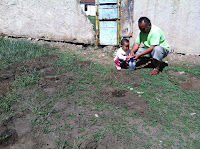 |
| Poster from Javkhlant school, Uliastai soum |
So, October is Dental Awareness Month. Well, not officially,
but here in Uliastai, it might as well be.
This month, the Dental Awareness Project has launched at four
of the five Uliastai secondary schools, as well as in Yaroo soum, Aldarhan soum
and Tsagaanhairhan soum. The project involves all the 8th graders
from these schools, and occurs in two to three stages, depending on who you ask
and what you define as a ‘stage’:
It begins with a poster contest, with each 8th grade class working in pairs to design a poster about dental health. The posters are judged, and the winning pair gives a pre-made presentation about dental health and receives a certificate.
 |
| The dental posters from Aldarkhaan soum |
 |
| Students at Devshil school, Uliastai soum giving the presentation |
 |
| Winning students from Javkhlant school, Uliastai soum |
 |
| Students from Chandmani-Erdene School, Uliastai soum, playing a game as part of their presentations |
That, at least, is the basic structure. All the schools,
even individual classes, do the competitions a little different. Sometimes all
the students present on dental health together. Sometimes they make another
presentation in addition to the pre-made PowerPoint. Sometimes the posters are
less like posters and more like brochures. But in all cases, students are
learning about dental health, so the variations don’t bother me in the least.
In addition, I’ve been doing dental assessments in
preparation for the KIDS dental Dream Team coming in May. This has involved
visiting all five schools in Uliastai and those at two of the outer soums, looking
at the teeth of over 850 children. And it’s not done yet. I’m scheduled to go
out to a number of soums to look at teeth and facilitate the soum school’s
participation in the Dental Awareness Project.
 |
| Dental assessments, Chandmani-Erdene school |
I guess I kind of got lucky with this project. I think about
the projects I tried to do last year, many of which ended in disastrous
failures. Sometimes I thought the failure may have been a result of the
projects being too widespread, but the dental project is now aimag-wide.
Sometimes I thought it might be because it involved too many parties, but the
Dental Project has involved teachers, directors, social workers, training
managers, doctors, and volunteers from all the school.
So what makes this project such a success? I think it’s a
combination of a few things, and with those things in mind, I’m writing a list
of tips for future projects—as much for myself as anyone:
Hit on a need: When working on my Teaching Methodology
Seminar, I had grand plans. The problem, though, is that no teacher is really
that interested in improving his or her methodology; you’re not going to be
fired for using an older methodology. But walking through town, you can look at
our children’s teeth and know there’s a problem. In some cases, the teeth are
literally rotting out of their mouths. But people who have seen it sometimes
don’t really SEE it until you bring it up. Then, suddenly, you get those “Ah…!”s
of recognition, and people are immediately onboard.
Make it easy: I wanted to do Lifeskills for the longest time
(and still do). I went to the librarian at Bookbridge, the workers at
WorldVision, and other people in the community asking for help. But no one
wants to spend 2-3 hours a week teaching Lifeskills for free--teaching is a lot
of work! When I went to schools, though, and met with the director about the
Dental Awareness project, I came with a flyer of the project (in Mongolian)
that could easily be edited, the dental presentation (in Mongolian) with
pictures to show them, and a copy of the certificate, sometimes even an example
printed on the nice certificate paper and sign and stamped (and looking nice!).
It involved no work on the part of the director or, really, the teacher. It was
an out-of-the-box deal. Easy.
 |
| Cuteness on wheels |
All for the children: Children are so treasured here. I wish
I had a picture of all the ways I’ve seen this demonstrated: old grandfathers
carrying little children on their back, or rocking them as they slept on their
shoulders; fathers scooping up their toddlers and ‘sniffing’ them
affectionately; mothers cleaning them, playing with them, smiling at them as
they called “minii khuu!” (my child!). The Dental Project is directly related
to the health of children, and no one can, with good conscious, reject a
project that focuses on such an important topic.
I guess an unofficial fourth tip would be to incorporate flexibility into everything. Every school does the project different, and why shouldn't they? Every child is different, every need is different, every situation is different. And I've rescheduled the project a dozen different times, but at least it's moving forward. I guess that's the way community development goes: it takes times, but as long as you're moving forward, that's what counts.
I hope things continue to move forward on this and other projects. I'm bolstered by my success this month, and hope November proves just as productive.
A quick shout-out to Purobi, who looked over the dental presentation for me, Bob, who taught me how to do dental assessments, and Bryan, Virginia, and Zack, who helped me do the dental assessments both at their schools--and others, as well. As in all successful projects, it's been a group effort.
Cheers,
Karen














